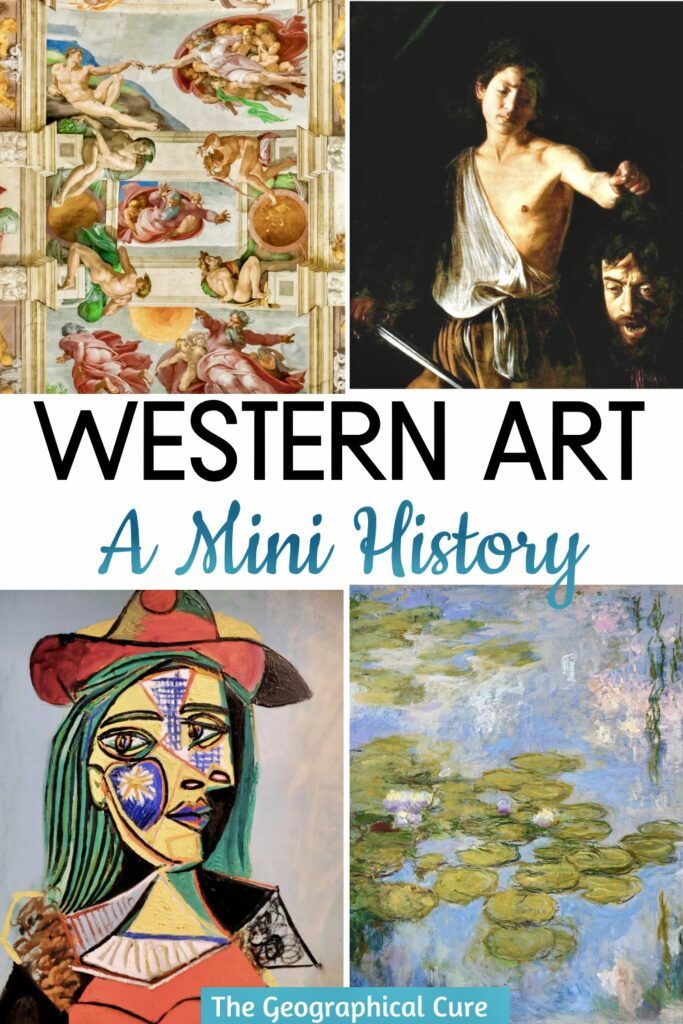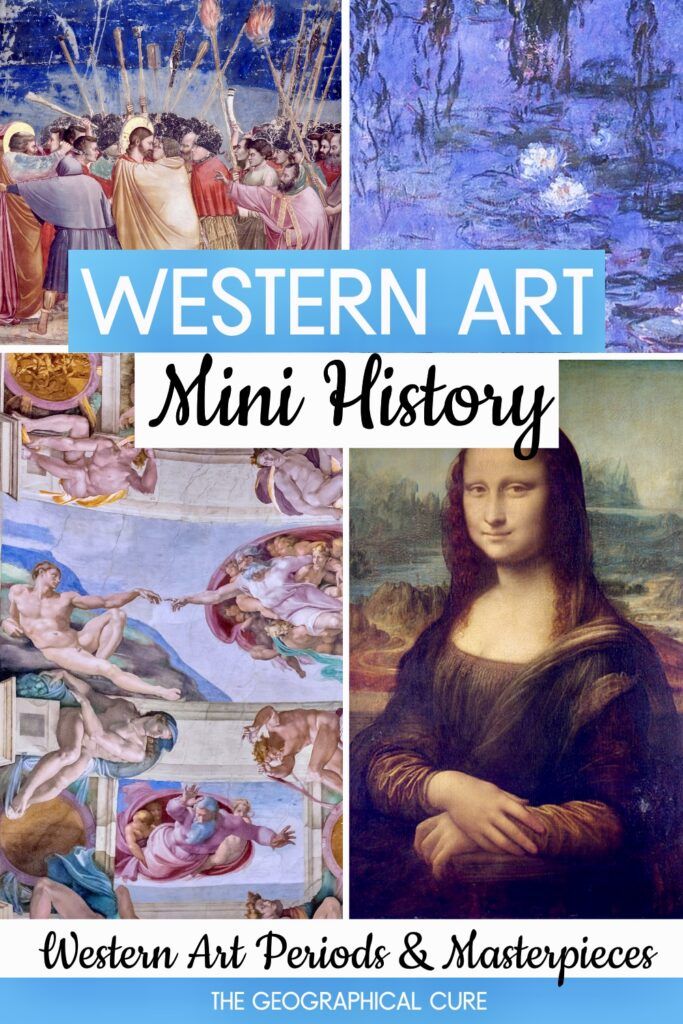The purpose of art is constantly changing. Art expresses a vast variety of emotions, believe, and ideas — beauty, truth, hope, death, life, chaos, etc.
Art can be decorative, narrative, philosophical, religious, or simply entertaining. And it always chronicles and mirrors the age in which it was created.
Art movements often emerge as a reaction to or an evolution from the preceding era. Certain styles may experience a renaissance or reinterpretation in subsequent periods
In this guide, I give you an introduction, in chronological order, to the most important movements and styles in Western art. I also tell you about the artists and works that defined these periods.
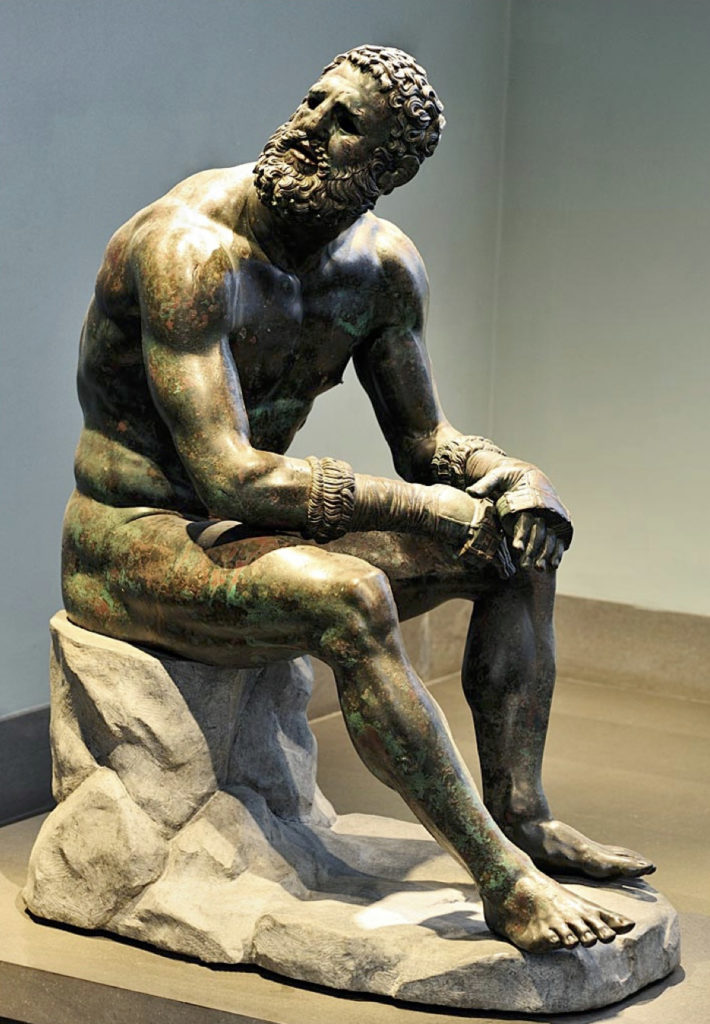
Pocket Guide To Western Art History
Antiquity | Classical
The earliest period of art is Antiquity, the ancient Greek and Roman period. It began around 800 BC and continued until the fall of the western Roman Empire in 476 AD.
“Antiquity” is the word used to describe this period. The word “Classical” is the term used to describe a particular artwork, painting, or building.
This period of Western art focused on aesthetics, harmony, proportion, balance, and the beauty of the human body. While aiming for realism, classical art also sought to idealize the human form, representing it as a paragon of beauty and physical perfection.
Some of the most notable works from this era are Laocoön and His Sons (Vatican Museums), Venus de Milo (Louvre), Boxer at Rest (Palazzo Massimo), and the frescos from Pompeii.
Middle Ages | Medieval
After Antiquity comes the Middle Ages. This period falls in the middle of the cultural period of Antiquity and its revival in the Renaissance.
The Middle Ages begins with the fall of the Roman Empire in approximately 500 AD and continues all the way to 1400 AD or so.
The adjective used to describe art from this period is “Medieval.” Medieval paintings drew on a wide range of artistic traditions, including Byzantine, Romanesque, and Gothic styles.
To dig down further, historians often refer to the first 400 years after the Roman Empire fell as the “Dark Ages.” There was a social and artistic vacuum after the demise of such a powerful empire.
However, historians no longer use the term “Dark Ages.” Today, they are referred to as the “Early Middles Ages.”
There were several art periods during the Middle Ages.
Byzantine Style
The first is the Byzantine style, which dominated western art from 500 to 900 AD.
With the spread of Christianity, the realism of Greco-Roman art was abandoned. Instead, artists created artworks with a strong sense of order, telling people about icons, saints, and scriptures.
The art looked rather exotic. It was flat and two dimensional.
Mosaics were used extensively. The most famous ones are found in the UNESCO sites of Ravenna Italy.
Romanesque Style
After that, the next style is called Romanesque. This period of Western art begins around 900 AD and lasts until 1200 AD.
Romanesque art is noted for its solidity, massive structures, and extensive use of stone. It was a period of great creativity in architecture, sculpture, and painting, influenced by Christian themes and the needs of the church.
Romanesque buildings were thick walled windowless buildings that weren’t decorated inside.
Example of this are the Leaning Tower of Pisa in Pisa, the Basilica of San Miniato al Monte in Florence, and the Basilica of Saint-Sernin in Toulouse France.
Gothic Style
After the Romanesque period comes the Gothic movement. Gothic art and architecture was produced over a 200 year period beginning in 1200 AD and 1400 AD.
This style was born in Paris in the Cathedral-Basilica of Saint Denis. It was prompted by a desire to change the way that Christian churches looked.
The Gothic style emphasized height and light. So what you get is buildings with pointed arches, spires, vertical lines and decoration — things that emphasized reaching up to the sky. The most famous element was the flying buttress.
In architecture, some of the best examples of the Gothic style are the cathedrals in Chartres, Reims, Notre Dame, Milan, Siena, and Florence.
In art, artists created works in the International Gothic Style. It began in Burgundy, Bohemia, France, and northern Italy in the late 14th and early 15th centuries. And then spread throughout Europe.
This style is characterized by elaborate and graceful decorations and vivid, detailed landscapes. The palette is bright and luminous, using rich colors and gold leaf. The most beautiful example of this is the stained glass in Paris’ Sainte-Chapelle.
In painting, artists prioritized symbolic representation over lifelike accuracy. Figures were static. Babies often looked like old men.
Renaissance
The Renaissance is a historic art period that begins in the 1400 and ends, depending on who you talk to, between 1700 and 1750. I adore this period of art.
Like the Middle Ages, there are different periods within the Renaissance.
Early Renaissance
The Early Renaissance began in approximately 1400 and ended in 1500. As the 15th century progressed, there was a renewed interest in classical art and humanistic themes.
International Gothic style gradually gave way to the early Renaissance style, although the division between periods wasn’t clean and neat.
Early Renaissance artists focused on a more naturalistic depiction of human emotions and anatomy. They chose mythological subject matter, not just religious subjects.
The early Renaissance featured artists like Giotto, Donatello, Botticelli, and Masaccio. Some of the most famous examples of their work are Giotto’s Scrovegni Chapel, Masaccio’s Branccaci Chapel, Donatello’s Bronze David, and Botticelli’s Birth of Venus and Primavera.
High Renaissance
The next Western art historical period is the High Renaissance. It lasted from 1500 to 1600.
This period marks a moment when artists had overcome technical difficulties of how to make things look real.
There was a new wave of artists, who focused on perfecting techniques to create a new level of expression. These artists drew inspiration from the art and architecture of classical antiquity, embracing Greco-Roman ideals of beauty and proportion.
There was a strong emphasis on harmony, balance, and proportion in compositions. Artists mastered the use of linear perspective, a technique that creates the illusion of depth on a flat surface, making scenes appear more realistic.
The painting that really kicked off the High Renaissance was Leonardo da Vinci’s The Last Supper in 1495. It looks less like a staged event. It’s almost like Leonardo was in the room with a camera.
Consider Michelangelo, perhaps the most celebrated High Renaissance artist. He produced the frescos on the Sistine Chapel and his beautiful David and Pieta sculptures.
The other most significant artist was Raphael, famed for paintings like the School of Athens in the Vatican Museums.
The High Renaissance wasn’t limited to Rome and Florence. The Renaissance also occurred in Europe north of the alps.
There were great achievements in the newly developed medium of oil. My favorite northern Renaissance artist was Albrecht Durer.
His most important work, Self Portrait at 28, is in the Alte Pinakothek in Munich and is one of the first ever “selfies.” The Albertina Museum in Vienna has the world’s largest collection of his drawings.
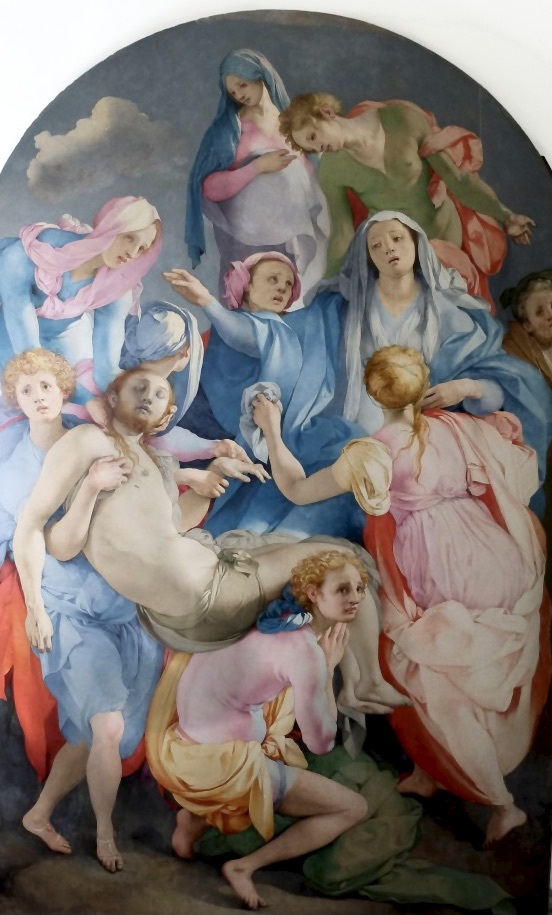
Mannerism
Emerging around 1520, Mannerism marked a distinct shift away from the High Renaissance’s naturalistic ideals.
This movement introduced a unique, exaggerated style as artists sought to break free from Renaissance constraints, emphasizing subjective interpretation over harmony and balance.
Characterized by vibrant colors, elongated forms, and intricate compositions, Mannerism celebrated art’s artificiality, likened by some to jazz for its unconventional approach.
Michelangelo, with works like The Last Judgment, is often cited as a precursor to Mannerism. He influenced other artists like Rosso Fiorentino, Bronzino, Pontormo, and Parmigianino.
Initially criticized, Mannerism’s rich, sophisticated style is now recognized as a significant era in art history.
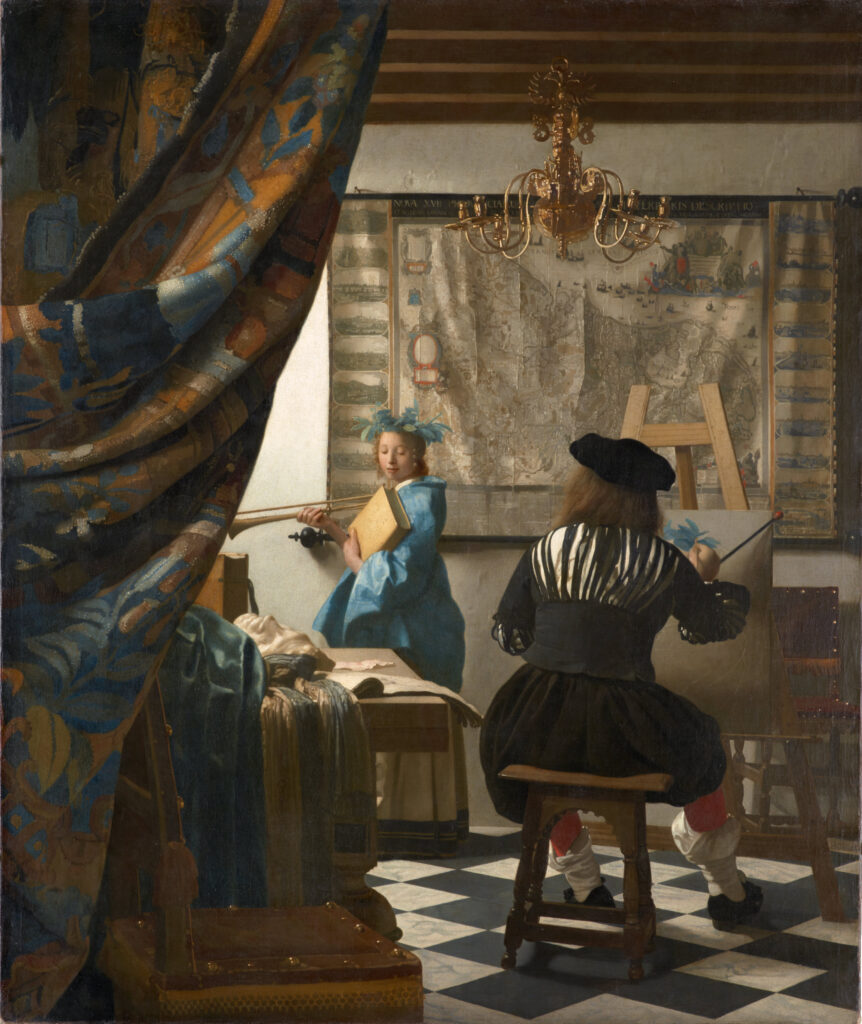
Dutch Golden Age
The Dutch Golden Age was a period of great wealth, cultural achievement, and artistic flourishing in the Netherlands, particularly during the 17th century.
This Western art period is known for its attention to detail, realism, and themes of daily life, landscapes, still lifes, and portraiture. It departed from the Renaissance focus on religious and mythological subjects.
The theory behind it was that even small and seemingly insignificant things are part of world and should be appreciated.
Artists like Rembrandt van Rijn, Johannes Vermeer, Frans Hals, and Jan Steen are among the most celebrated figures of the Dutch Golden Age. Their works are admired for their innovation in technique, lighting, and subject matter.
Baroque
The next Western art period after the Renaissance was the Baroque. This period emerged in the late 16th century and lasted until the early 18th century.
The name derives from barocco, or misshapen pearl. And it describes art that combined emotion, dynamism, and drama with powerful color and tonal contrasts.
Baroque art was much more over-the-top than the Renaissance. New techniques, like tenebrism, were developed to create dramatic effects of highlight and shadow.
Brushwork became expressive and broad. It was an ornate, theatrical style that combined realism and grandeur.
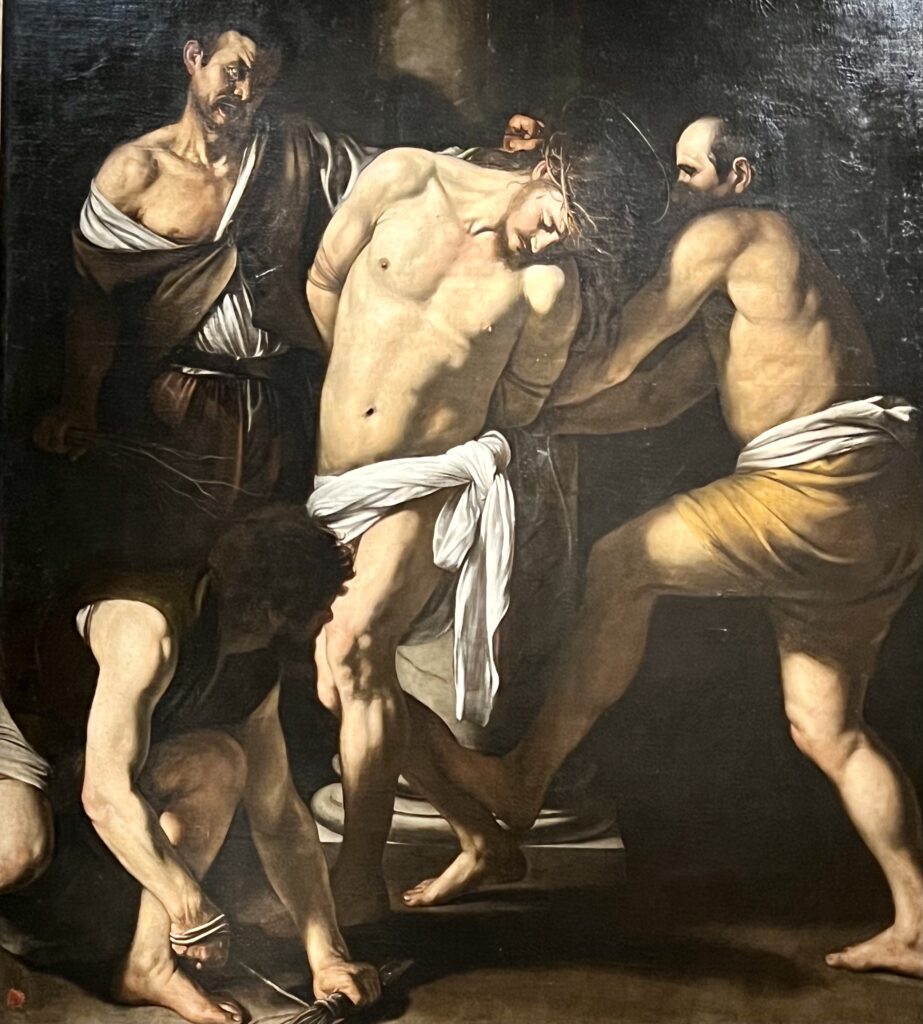
Perhaps the most singular and influential Baroque artists were Caravaggio and Bernini.
Caravaggio broke away from the sanitized idealism of the Renaissance. He embraced a plebeian perspective of Christianity.
His naturalistic and emotionally charged works were considered shockingly realistic for the time, introducing a raw bluntness to the art world.
Bernini was celebrated for his ability to create theatrical sculptures. His masterful works, such as those in Rome’s Borghese Gallery, showcased his innovative use of light, space, and movement, capturing the emotional intensity of a moment.
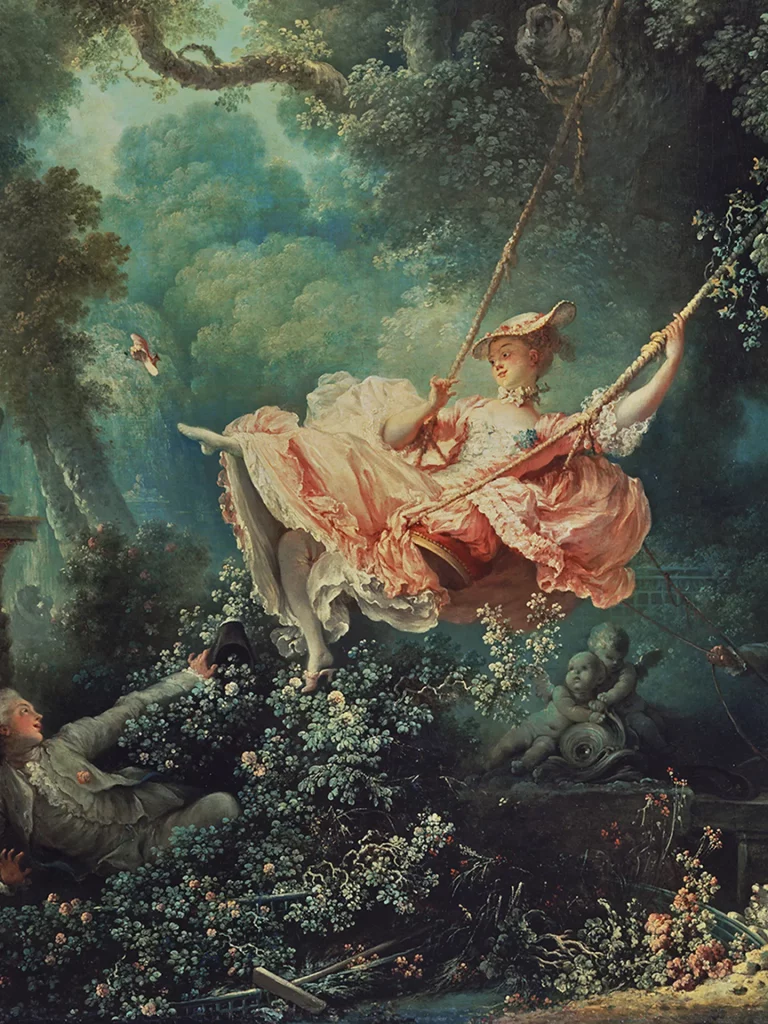
Rococo
The Rococo period of Western art is a bit of an extension of the Baroque and lasted from 1700 to 1750.
Rococo is essentially an explosion of decoration. When you think of Rococo art, you might think of Versailles.
Rococo is characterized by soft pastel colors, curving lines, and themes of love, nature, and light hearted entertainment.
Some of the most famous Rococo artists were Francois Boucher, Jean-Antoine Wateau and Fragonard. Fragonard’s The Swing, housed in London’s Wallace Collection, is the most famous example of Rococo painting.
Neoclassical
Inspired by the excavations at Pompeii, a new interest in the arts of the antiquity appeared in the Neoclassical period. It lasted roughly from the 1760s to the 1830s, beginning in Rome and spreading through Europe.
Neoclassical artists embraced order and restraint in reaction to the frivolity of the Rococo.
They wanted art to be serious and express patriotic and heroic themes. To express that, they used smooth contours and polished surfaces with no discernible brushwork.
The most famous Neoclassical artists were Ingres and Jacques-Louis David, whose masterpieces you can see at the Louvre.
Romanticism
The Romantic period emerged as a reaction against the order and rationality of the Neoclassical period. It lasted from roughly 1800 to 1850.
This art period emphasized passion, individualism, and moving themes. Emotion was glorified over logic.
It was marked by a fascination with the past, the exotic, and the mystical. Nature, with its beauty and potential for disaster, was a major Romantic theme.
Classic paintings personifying this period of Western art are Delacroix’s Liberty Leading the People and Gericault’s Raft of the Medusa, both at the Louvre.
Realism
By the mid 9th century and after the French Revolution, artists aimed to paint the world directly as they saw it. Like most art periods, Realism was a reaction to the excesses of Neoclassicism and Romanticism.
Artists portrayed the human body with a new frankness and focused on social inequity and working class life. They aimed to show truth and avoided stylization. At the time, their plebeian subjects shocked upper and middle class viewers.
Some of the most famous Realists were Gustave Courbet and Jean-Francoise Millet.
Impressionism
Impressionism originated in France. It was a then radical group who focused on capturing the momentary effects of light and color in landscape and urban scenes. It lasted from about the 1860s to the 1890s.
Impressionists broke away from the conventions of academic painting, using sketchy loose brushwork and a brighter palette to capture the transient impression of a moment.
They often painted outside, in “plein air.” Their main subjects were landscapes, but they also painted portraits and leisure scenes.
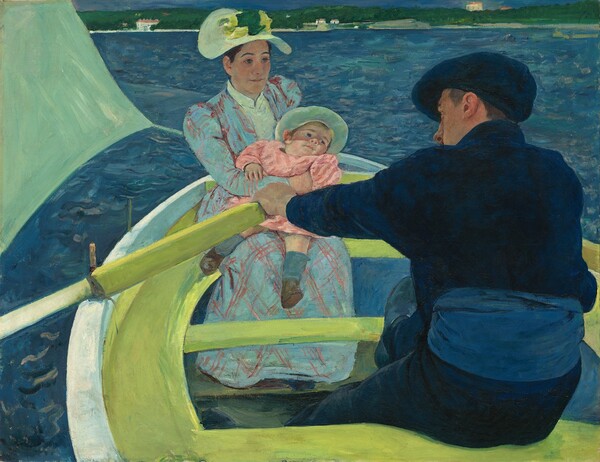
The founder of Impressionism and its most famous artist was Claude Monet. Other Impressionists included Pierre-Auguste Renoir, Camille Pissarro, Alfred Sisley, and Mary Cassatt.
Some historians lump Edgar Degas and Edouard Manet in this group as well. But they had distinct approaches and maintained different identities.
Because Americans were fascinated by Impressionism, there are examples in virtually every major US museum.
In Paris, you can find Impressionist paintings in the Musee d’Orsay, the Orangerie, and the Musee Marmottan Monet. In the United States, the best Impressionism collections are at the Barnes Foundation in Philadelphia and the Art institute of Chicago.
Post-Impressionism
The term Post-Impression encompasses several styles, lasting from 1886 to 1905. The term was only invented well after the movement ended.
They adopted new approaches to color and shape. The Fauves favored bright, sometimes garish, colors. The Pointillists focused on optical effects.
They all had unique styles. But the commonality was that they expressed less about what they saw and more about what they thought.
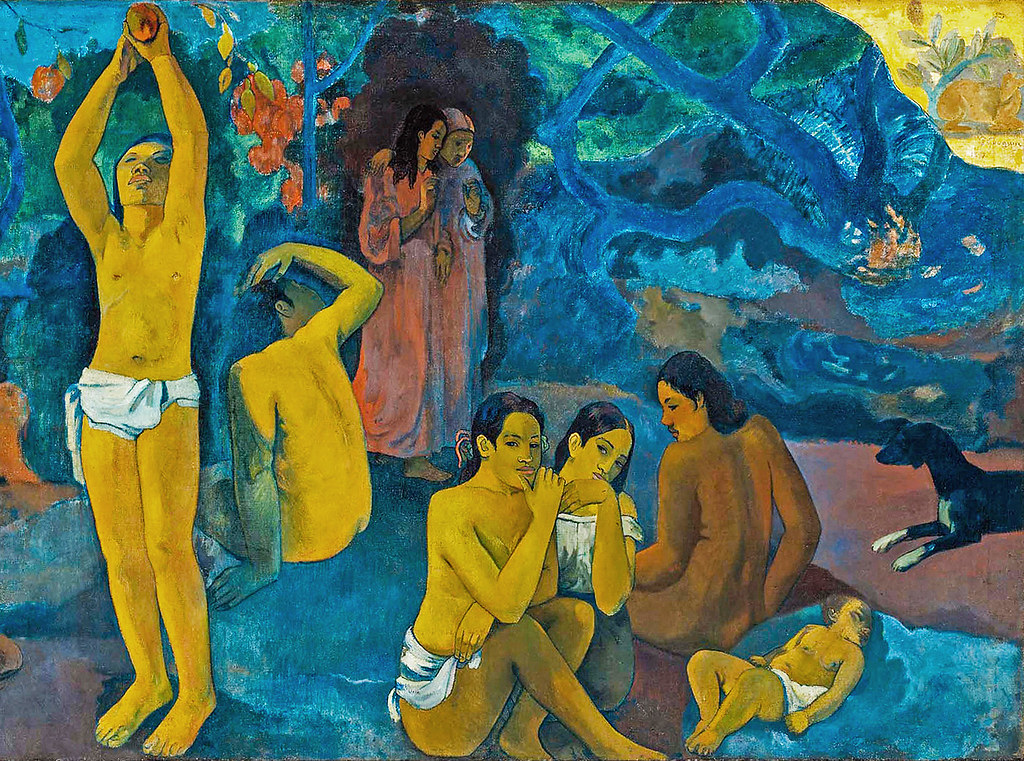
Post-Impressionist artists included Paul Cezanne, Vincent Van Gogh, Paul Gauguin, and Henri de Toulouse-Lautrec. Picasso described Cezanne as “the father of us all.”
Van Gogh is perhaps the most famous and beloved of the Post-Impressionists. His works were characterized by bold, expressive brushwork, vibrant color palettes, and emotional depth.
Despite struggling with mental illness, he produced some of the most famous paintings in art history, including Starry Night, Sunflowers, and his many self portraits.
Like the Impressionists, the Post-Impressionists were pioneers in introducing early concepts of abstraction in art.
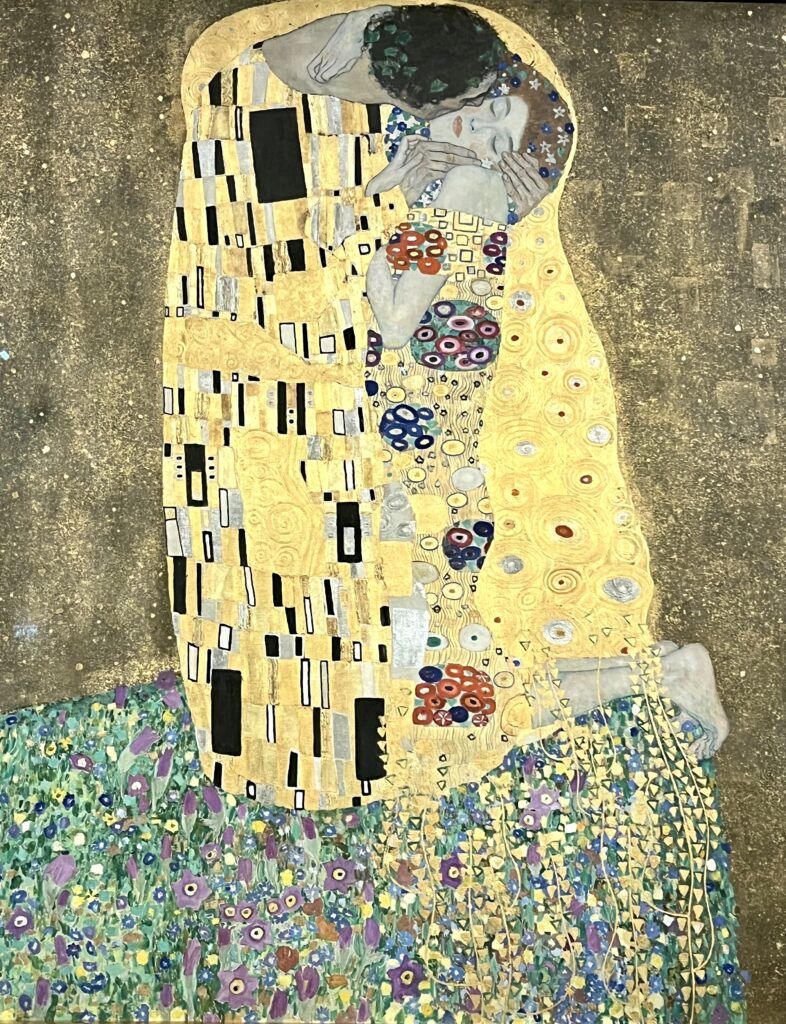
Art Nouveau
The period of Art Nouveau and the Viennese Secession dates from the 19th century to the early 20th century, roughly from 1890 to 1910.
It was a pioneering art movement that boldly embraced modernism. Rejecting the conventions of traditional academic art, it celebrated groundbreaking forms, materials, and styles.
The group favored flowing lines, organic shapes, geometric abstraction, decorative motifs, and stylized ornamentation.
The main artist you think of with Art Nouveau is Gustav Klimt, the Austrian painter. He was known for his famous golden paintings, like The Kiss at Vienna’s Belvedere Palace.
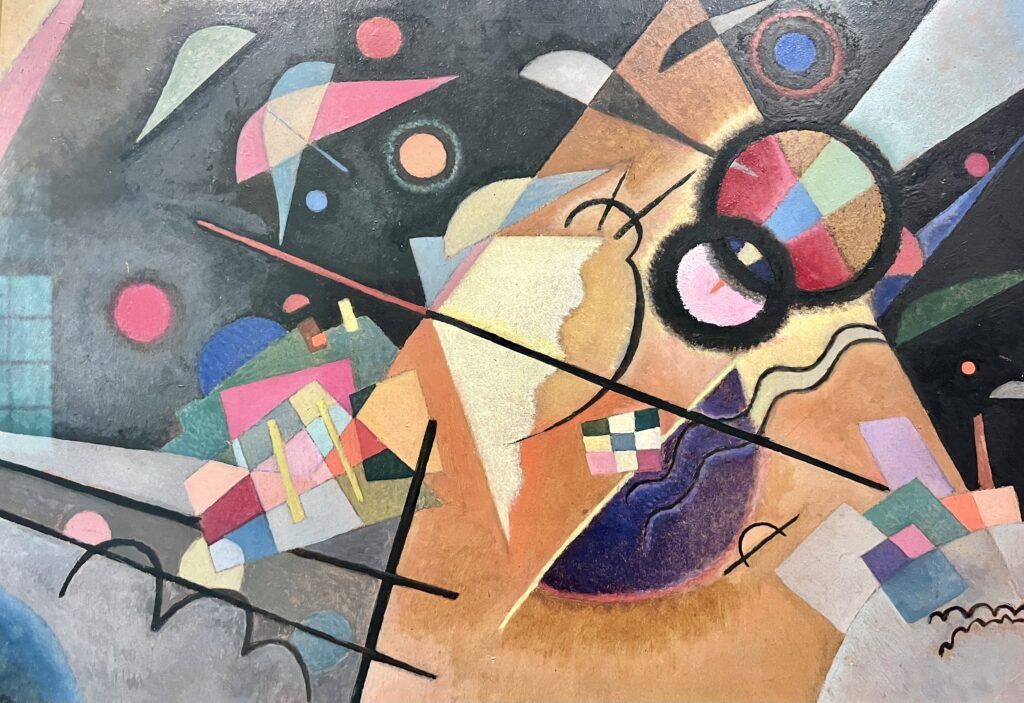
Modernism
Modernism is a broad umbrella term that encompasses a variety of movements, styles, and attitudes.
They all shared a common desire to break with the past and experiment with new forms of expression. This period spans roughly from the late 19th century to the mid 20th century.
Early 20th Century
The early 20th century saw the development of Symbolism, Cubism, Futurism, Suprematism, Dada, Magical Realism, and Surrealism. The great pioneers were Picasso, Paul Klee, Wassily Kandinsky, Marcel Duchamp, Edward Hopper, and Frida Kahlo.
Picasso was perhaps the greatest artist of the 20th century. He revolutionized the art world and dabbled in all forms of art and styles.
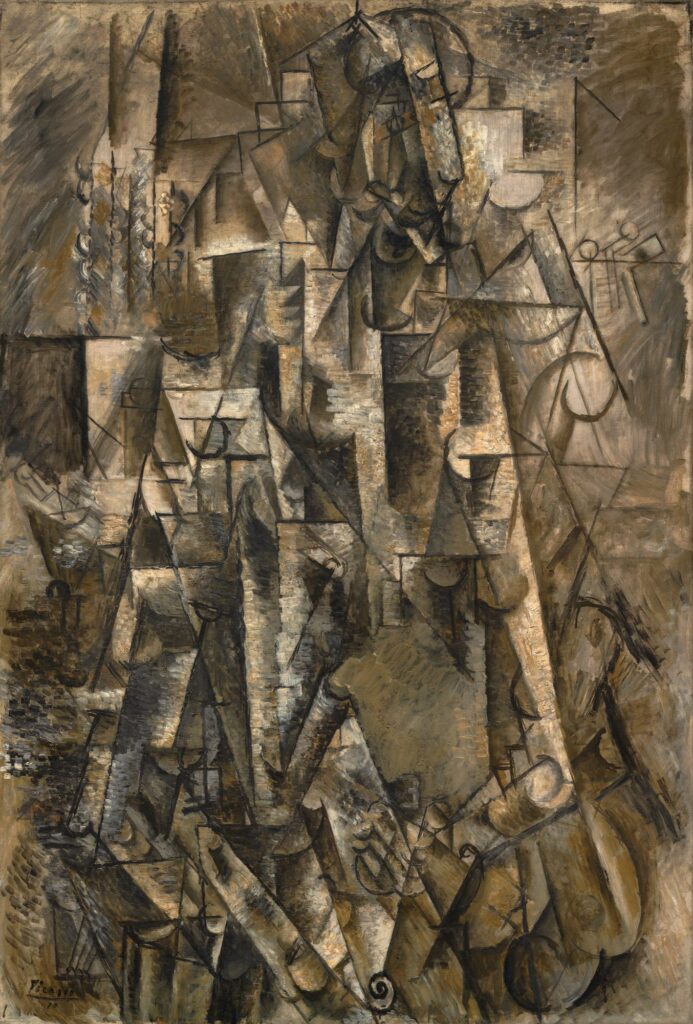
Cubism was likely his greatest contribution, though I must admit it is my least favorite genre.
Cubism was an avant-garde art movement that revolutionized European painting and sculpture in the early 20th century. It was primarily developed by Picasso and Georges Braque.
Characterized by fragmented objects and multiple viewpoints combined into a single composition, Cubism challenged traditional perspectives and emphasized the flat, two-dimensional surface of the picture plane.
Magical Realism is one of the most interesting Western art periods. It slowly evolved, from the 1920s through the 1940s. It wasn’t really an “ism.” The artists all worked independently.
There was a focus on underlying emotions. They were portrayed in a style that was partly representational and partly fantastical.
Some examples of this style are Kahlo’s The Two Fridas and Leonora Carrington’s The Giantess.
Surrealism was officially launched as a literary, political, and art movement in 1924. Artists sought to express unconscious feelings and thoughts.
Andre Breton was the leader, and heavily influenced by Dada and Freud’s psychoanalytical theories. The Surrealists painted dreamlike scenes and illogical juxtapositions, exploring and identifying processes of the unconscious.
The most prominent artists from this movement were Salvador Dali, Max Ernst, Rene Magritte, and Joan Miro.
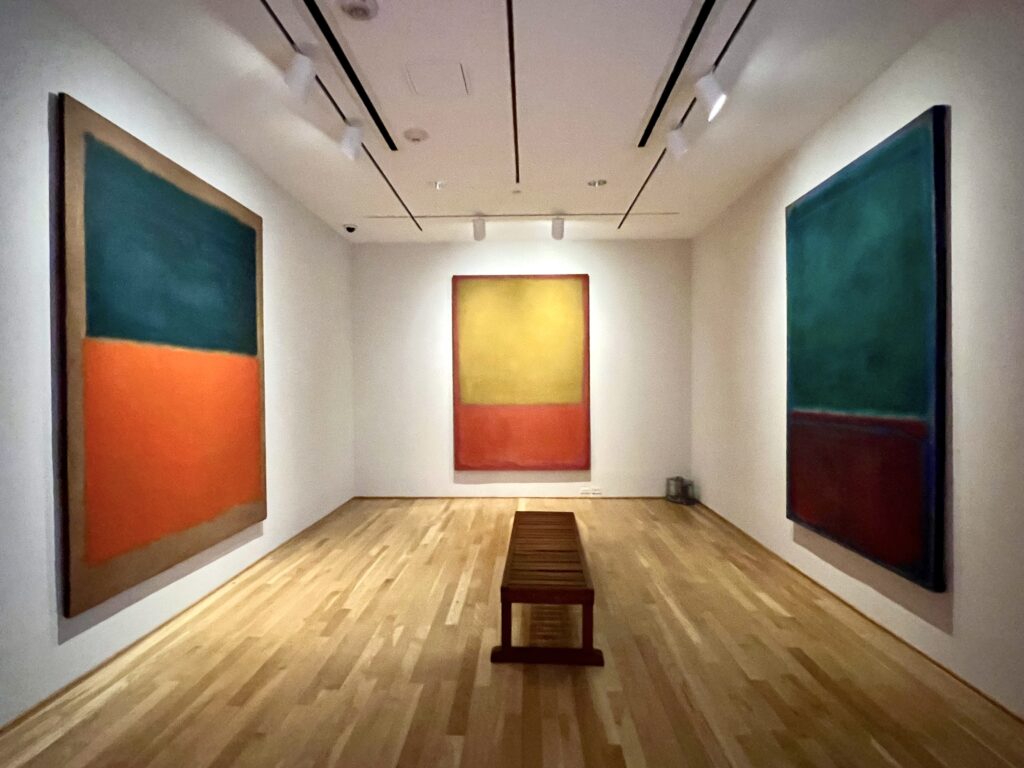
Mid 20th Century
The mid 20th century is associated with Abstract Expressionism, Pop Art, Performance Art, and Minimalism.
Abstract Expressionism was the first specialty American art movement. It shifted the world’s focus from Europe to the United States.
This movement was dominated by artists like Jackson Pollock, Mark Rothko, and Joan Mitchell. Seeking to find something beneath appearances and to express inner emotions, this intellectual movement emphasized spontaneous, automatic, or subconscious creation.
Pop Art was a radical reaction against the pretensions of Abstract Expressionism, drawing on popular and commercial culture. It developed in both New York and London.
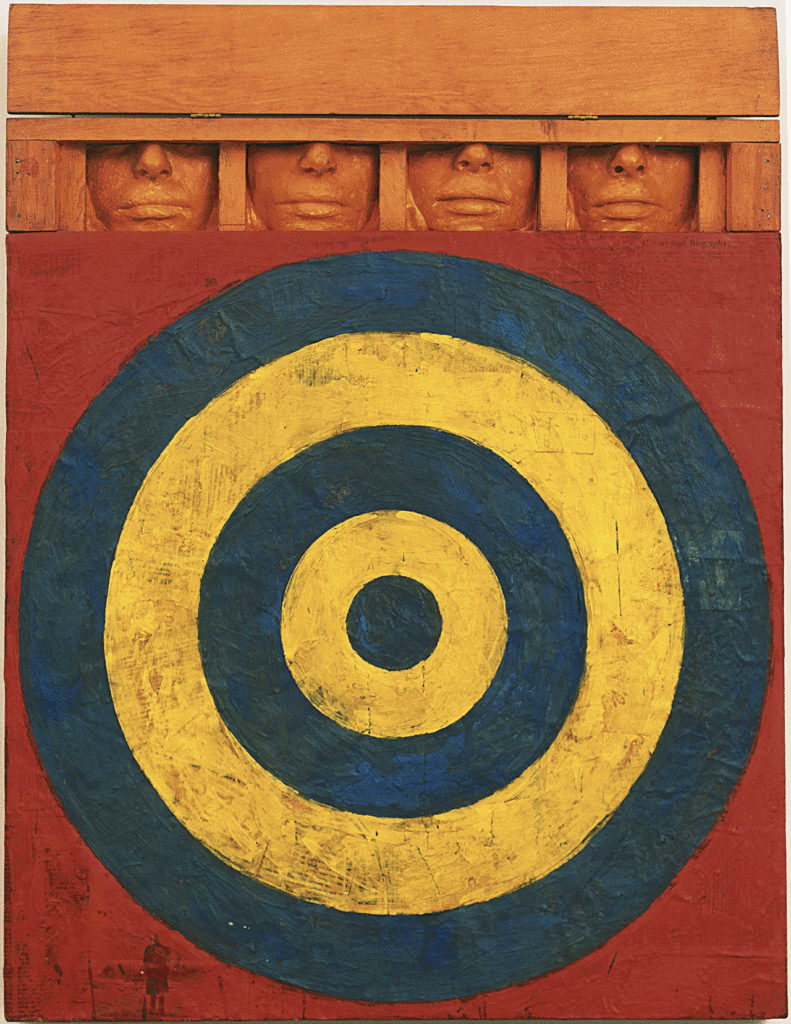
Pop artists, like Andy Warhol and Jasper Johns, produced images based on things most people could relate to — advertising, film stars, comic strips, flags, and food. They blurred the distinction between commercial and fine art.
Performance Art is art presented to a live audience. It was popularized in the 1960s and the genre never disappeared. Artists focused on themes of activism, personal narrative, and cultural critique.
The “grandmother” of performance art is Marina Abramović. Her most famous work, The Artist is Present from 2010, involved sitting in silence at the Museum of Modern Art in New York and making eye contact with any visitor who sat opposite her.
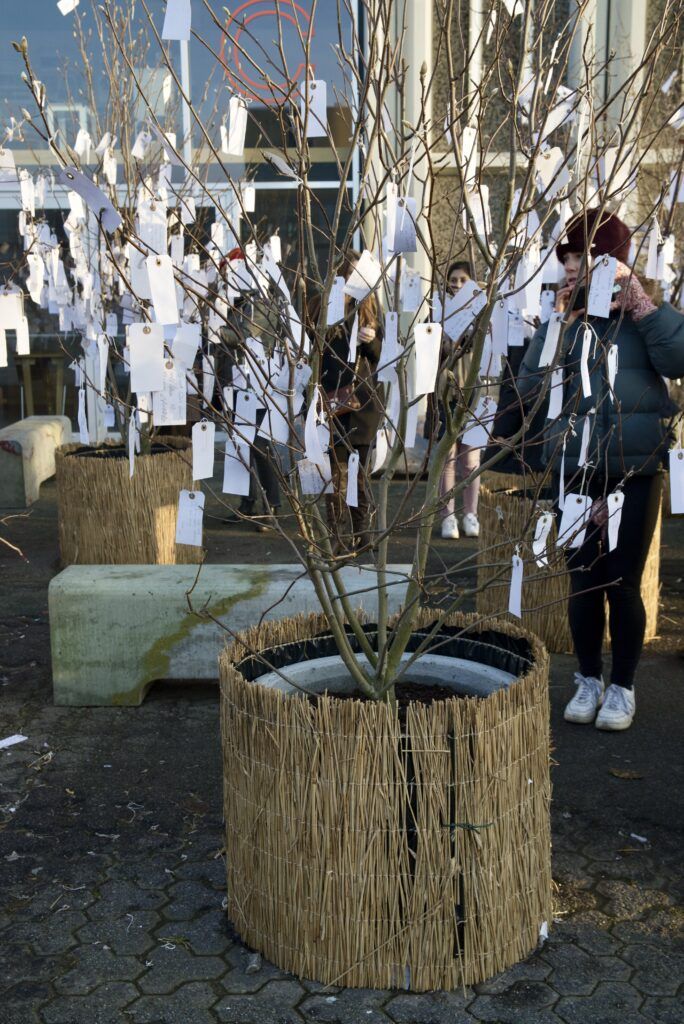
Yoko Ono was another prominent performance artist. Her works, like Cut Piece, Ceiling Painting, and Wish Tree explore themes of vulnerability, trust, optimism, and materialism.
Minimalism focused on the idea of simplicity and objectivity. Artists sought to reduce art to its essential form and concept, stripping away any and all form of representation.
It was a style of detached restraint. The term Minimalism was chiefly used to describe American sculptors, like Donald Judd and Richard Serra. They reevaluated spaces around them and used industrial materials.
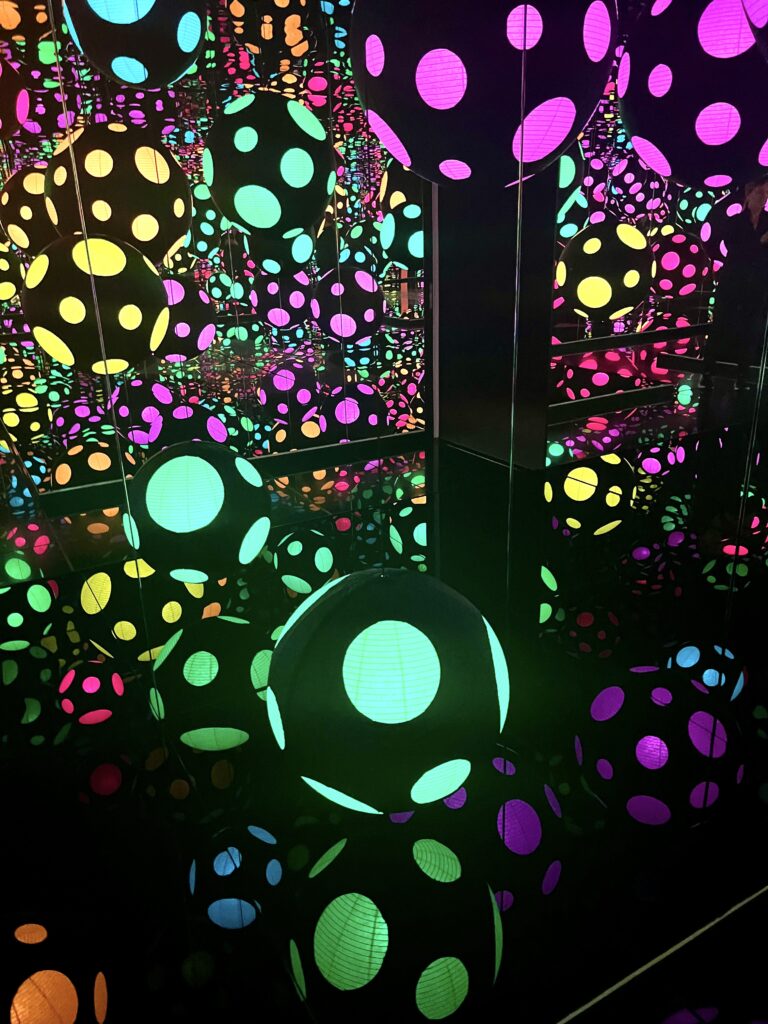
Contemporary Art
Contemporary art takes many forms — digital art, street art, installation art, performance art, photorealism, and environmental art.
Contemporary art mirrors the complexities and nuances of the globalized world we inhabit. It embraces a multitude of forms, materials, and concepts to explore issues pertinent to the current moment.
This era of Western art is characterized by its global nature, accessibility, and the way it engages with social, political, economic, and environmental themes.
Artists leverage technology, new media, and unconventional materials. All of this while reflecting on the digital age, the impact of social media, human rights, and the interconnectivity of societies.
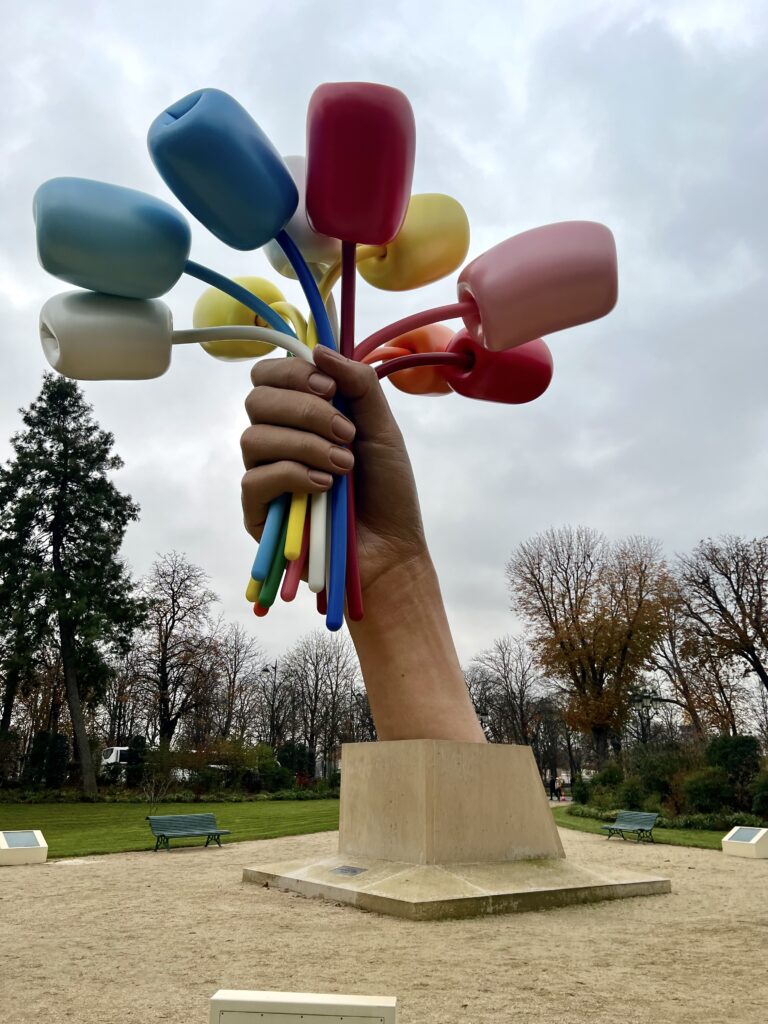
The contemporary art scene is also notable for its inclusivity and diversity, providing a platform for voices from varied cultural, social, and gender backgrounds.
The fluidity and openness of contemporary art encourages ongoing dialogue and reflection, making it a vital part of cultural discourse and a mirror reflecting the ever-evolving human condition.
Some of the most famous contemporary artists are Yayoi Kusama, Damien Hirst, Jeff Loons, Banksy, Anish Kapoor, and Kehinde Wiley.
I hope you’ve enjoyed my concise history of Western Art. You may enjoy these other museum guides:
- Best Museums in Italy
- Best Museums in Spain
- Best Museums in Rome
- Best Museums in Florence
- Best Museums in Paris
- Best Museums in Vienna
- Best Museums in London
- Best Museums in the United States
- Best Museums in New England
- Best Museums in Washington DC
- Best Museums in Philadelphia
If you need a mini history of Western art, pin it for later.

